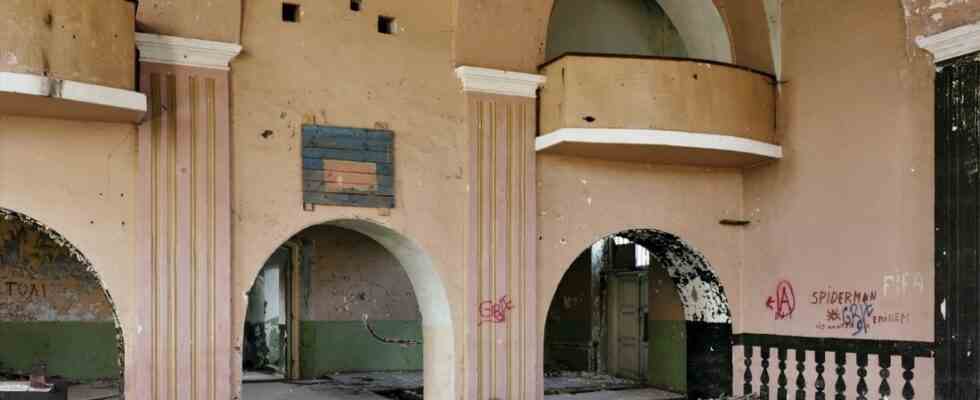Destroyed buildings, crumbling walls, peeling plaster. No one in sight. The photographs are almost ten years old, but they are still painful. In 2013, Johanna Diehl searched for traces of Jewish life in the Ukraine, photographed dilapidated or misused synagogues and documented a history of destruction, decay and transformation in her “Ukraine Series”. Many of the synagogues were destroyed during the German occupation, while others were disrespectfully misused under Soviet rule. Sports clubs, fitness studios, theatres, cinemas and drugstores moved into the rooms. Diehl captured everything soberly – the ugly fixtures, the garish colors as well as the comparatively aesthetic ruins. But it’s possible that there isn’t anything left at all.
The photographer, born in Hamburg in 1977, is one of the 15 photo artists currently gathered in the Augsburg Glass Palace. Curator Thomas Elsen called the show “European Trails”, in which Letizia Battaglia, Kathrin Ganser, Magdalena Jetelová, Herlinde Koelbl, Youqine Lefèvre, Tina Modotti, Loredana Nemes, Leta Peer and Joanna Piotrowska, among others, deal with origins, memory and identity . The must-see show was planned and developed well before the start of Russia’s war against Ukraine, but now some of the work is tremendously timely.
The Russian Anastasia Khoroshilova researched the fate of war veterans in Latvia.
(Photo: Anastasia Khoroshilova, courtesy the artist)
Just a few meters away from Diehl are pictures of the Russian Anastasia Khoroshilova, born in Moscow in 1978 and living in Berlin. Together with the journalist Annabel von Gemmingen, she traveled to Latvia 25 years after the collapse of the Soviet Union to research the fate of war veterans. Her recordings tell of Latvians who fought on the German or Russian side and of Russian-speaking veterans who live stateless in Latvia. Once highly decorated for their merits on the battlefield, they are now “The Remnant,” as the series is titled. Elsen only chose pictures without people: interiors and above all chairs that tell a lot about their inhabitants. Awards and medals crowd the uniform jackets hung over the backs of chairs. One photo stands out: a close-up of aged white skin with freckles, moles and a thinly healed gunshot wound. How vulnerable everything is.
The art of Beate Passow, born in 1945, is also politically represented in the exhibition with three large-format tapestries from her cycle “Monkey Business”. The black-and-white, freely hanging carpets are based on photo collages that the artist put together from press photos on the computer and address European problems and developments, such as the yellow vest protest movement in France. Oversized, Passow mounted the damaged bust of “Marianne” in the angry crowd that tore and destroyed the French national figure from the Arc de Triomphe during a demonstration in 2019. In the “Budapest” collage (2020) she shows the Shoah memorial on the Danube, towered over by Buda Castle, Viktor Orbán’s seat of government. Anti-Semitism, racism, dictatorship efforts – the picture sums it all up, almost too clearly the Hungarian eagle carrying a tablet with a photo of a refugee child.
Beate Passow combines the Hungarian eagle carrying a tablet with a photo of a refugee child with the Shoah memorial in Budapest.
(Photo: Beate Passow, courtesy the artist, VG Bild-Kunst, Bonn 2022)
Andrea Geyer’s complex installation “Feeding the Ghosts” is a very special experience. 21 slide projectors throw white, empty pictures on the wall, only their own shadow enriches the frames. Geyer’s voice can be heard from the off, she speaks a text in which she contrasts and interweaves her own experiences of loss with the reflections of the Belgian filmmaker Chantal Akerman on the long-lasting effects of the Holocaust.
In contrast, Candida Höfer’s series “Turks in Germany”, produced between 1972/73 and 1979, seems like a trip to the early days of the Federal Republic. Katharina Sieverding’s “Stauffenberg-Block” (1969) is still extremely impressive. Larger than life and glowing red, the often alienated face of the artist looks into the hall, ashamed and angry about deeds that are simply swept under the table.
European trails. Contemporary European Photo Artists, until September 18, H2 – Center for Contemporary Art in the Glass Palace, Augsburg

